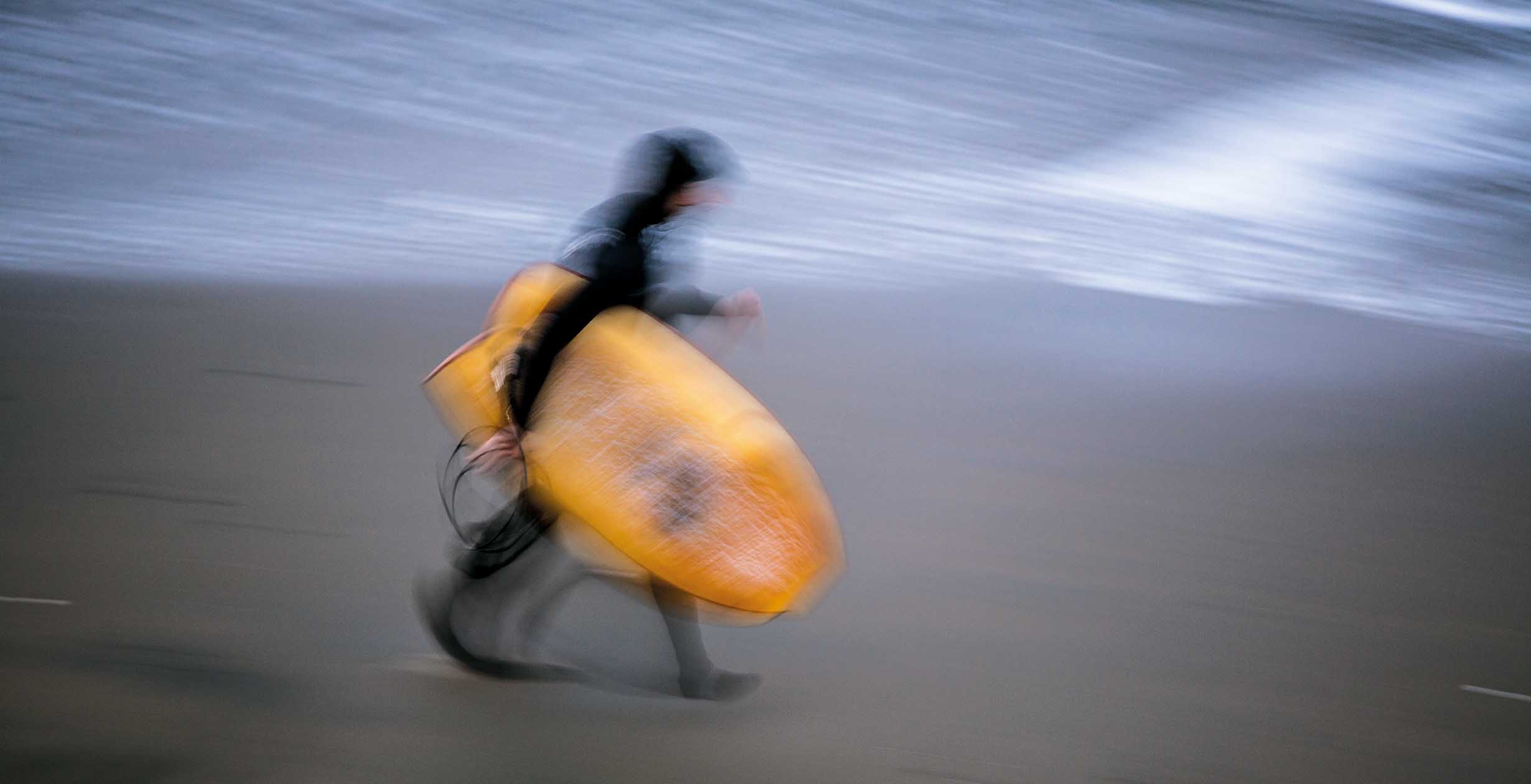A few years ago, inspired by vintage photos of Val Ching on his plywood paipo—and also by more-recent footage of Chris Del Moro and Ryan Burch on strangely short boards—I began tinkering, with minimalism in mind. Soon I was paddling into clean, shoulder-high peaks at Ocean Beach in San Francisco on a 4’0″ x 23″ x 3″ paipo-inspired, self-shaped twin-fin.
I found that once one adapts to the unique feel on takeoff, the benefits of these crafts begin to reveal themselves. They are very fast. Their shortness allows them to turn on a dime. They carry volume in their diminutive frames and paddle well. They are amenable to both points and beachbreaks. Underfoot they’re a versatile bit of board-technology: hang five, carve, spin, float, bob, weave. But, be forewarned, they often outrun the tube.
The controversial philosopher Martin Heidegger (who, despite his despicable politics, has had enormous influence on thinkers of every ideological bent) points out that the word technology originates from the Greeks: “Technikon means that which belongs to technê,” he writes. “Technê is the name not only for the activities and skills of the craftsman, but also for the arts of the mind and the fine arts. Technê belongs to bringing-forth, to poïesis; it is something [poetic].”
These boards are conducive to a freer type of surfing—for as Heidegger says, “man becomes truly free only insofar as he becomes one who listens and hears, and not one who is simply constrained to obey.”
He argues that in ancient Greece, technology focused not only on utility, but also encompassed truth and beauty. Modern technology, in contrast, forgoes the poetic unity of the true, the beautiful, and the useful. Instead it dismantles what it finds, revealing reality’s potential by “setting-upon” and “challenging” nature, thus putting upon it an “unreasonable demand.”
Heidegger compares the function of a windmill versus a hydroelectric plant. The windmill rides the wind, so to speak. Yet the wind is allowed to be the wind, even as its energetic potential for grinding grain is harnessed. It’s an example of what economist E.F. Schumacher would later call intermediate or appropriate technology.
In Heidegger’s eyes, the hydroelectric plant harnesses the power of the river, to be sure, but in so doing requires the flowing water to be dammed—thus setting upon and altering the river’s very essence. It ceases to be a river and becomes a “water power supplier.” Heidegger calls this modern tendency “enframing.” Perhaps the most worrisome example, for him, is the conversion of people into “human resources.”
Given this analysis, I would argue these quasi-paipos bring forth a more poetic form of surfing by allowing the possibilities inherent in a wide range of waves to reveal themselves, without forcing the surfer to set upon the sea. Such boards can hack and slash, but they don’t need to hack and slash to work well. They are also conducive to a freer type of surfing—for as Heidegger says, “man becomes truly free only insofar as he becomes one who listens and hears, and not one who is simply constrained to obey.”
I was tempted to force top turns along the inside section as it tapered down to a clean, knee-high line but that would also have been to obey the enframing constraints of the modern paradigm of surfing. Instead, I told myself to simply allow the waves to be what they were.
Consider the following: Recently, I was riding a 4’1″ at a right point in Santa Cruz. Initially, I was tempted to force top turns along the inside section as it tapered down to a clean, knee-high line. There would have been nothing wrong with that, of course, but it would also have been to obey the enframing constraints of the modern paradigm of surfing. Instead, I told myself to simply allow the waves to be what they were. On the outside bowl, I’d still go off the lip, but inside I’d move up to the nose and slide, in-trim, across the inner reef. I don’t know how it looked, but it certainly felt more graceful and poetic—and therefore more fun.
As Richard Kenvin has shown, boards in the Simmons tradition come with a truly ancient pedigree, descending, as they do, from the Hawaiian paipo. It also seems likely that surfing and its related technology in ancient Hawaii came far closer to the unity of truth, beauty, and utility that Heidegger praised in Greek technê and poïesis than do the commercialized forms of surf technology that dominate today. For those of us who are predisposed (along with novelist John Barth) to “rebel along traditional lines,” these neo-paipos, like the modern alaia, offer another (mercifully more buoyant) opportunity to unite contemporary and ancient tradition and design, perhaps allowing us to snatch some fleeting, poetic graces from the technocratic void.









